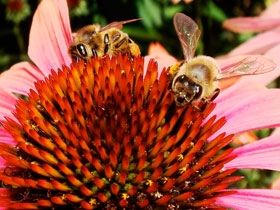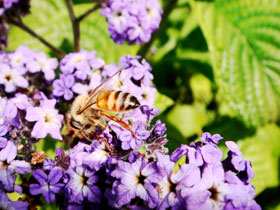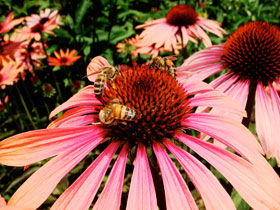Study Finds Bees Can Learn Differences in Food's Temperature
November 16, 2009
By Kim McDonald

Credit: James Nieh
Biologists at UC San Diego have discovered that honeybees can discriminate between food at different temperatures, an ability that may assist bees in locating the warm, sugar-rich nectar or high-protein pollen produced by many flowers.
While other researchers had previously found hints that bees might have the ability to do this, the UCSD biologists provide the first detailed experimental evidence in a paper that will be published in the December 1 issue of the Journal of Experimental Biology. An early online version of the paper is being made available by the journal this week.
"We show that honeybees have the ability to associate temperature differences with food," said James Nieh, an associate professor of biology who headed the study. "This information may help guide bees looking for food by allowing them to distinguish which bees are returning to the hive with the highest quality of food."
"Body temperature is seen in terms of its net caloric benefit to the other foragers," said Nieh. "The warmest forager in the nest is the one most likely to be visiting of the sweetest, highest quality food."

Credit: James Nieh
Nieh and researchers in his laboratory last year published a paper showing that bumblebees returning to their nests with higher quality pollen were warmer than bees that collected pollen with less protein. That gave the UCSD scientists evidence that bees may change their body temperature to reflect food quality, even for food that they do not consume and that has no direct metabolic impact on the bee.
Knowing that honeybees sense the temperature of returning foragers with their antennae, while these foragers conduct elaborate dances within the hive to communicate food location, Nieh and his colleagues wondered whether bees also sensed the temperature of their food. With the help of two undergraduate students, Tobin Hammer and Curtis Hata, he sought to find out whether bees possessed this ability.
Training bees to stick out their tongues in return for a sugary reward when the team touched a warm surface to a bee's antenna, the researchers found that bees could learn to identify warmth with food. Next, they tested whether the bees could learn to associate temperature differences with a food reward and discovered that this was also the case.

Credit: James Nieh
However, while the bees' abilities to recognize the temperature difference increased dramatically as the differences in temperatures rose, the scientists discovered that the bees were better at recognizing warm temperature differences than they were at cold temperature differences. In fact, the bees' abilities were twice as good at recognizing differences of 10 degrees Celsius above room temperature than they were at recognizing differences of minus 10 degrees Celsius below room temperature.
The researchers point out in their paper that this enhanced ability to distinguish warmer temperature differences could be an advantage for gathering nectar in many flowers. During the day, they note, temperatures in the centers of daffodils can be up to 8 degrees Celsius warmer than they are outside the flowers.
"A honeybee's ability to associate positive temperature differences with nectar rewards could also have a natural role inside the nest," the researchers conclude in their paper. "Honeybee foragers can elevate their body temperature after returning from a high-quality food source, and foragers returning from natural nectar or pollen sources increase their thoracic temperature when the colony has need for these resources."
The study was supported by the UC San Diego Opportunities for Research in Behavioral Sciences Program, which is supported by the National Science Foundation. ORBS is a program for high school students and undergraduates that provides research experience for students who are traditionally underrepresented in the sciences.
Media Contact:Kim McDonald, (858) 534-7572, [email protected]
